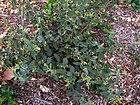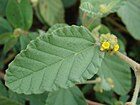Note: This is a project under development. The articles on this wiki are just being initiated and broadly incomplete. You can Help creating new pages.
Difference between revisions of "Waltheria indica"
(Created page with "{{stub}} ==Uses== {{Uses|}}, {{Uses|}}, {{Uses|}}, {{Uses|}}, {{Uses|}}, {{Uses|}}, {{Uses|}}, {{Uses|}}, {{Uses|}}, {{Uses|}}, {{Uses|}}.<ref name="Uses"/> ==Parts Used== {{...") |
|||
| Line 1: | Line 1: | ||
| − | + | [[File:Flickr - João de Deus Medeiros - Waltheria americana.jpg|thumb|right]] | |
| + | '''Waltheria indica''' is a short-lived, perennial plant producing several erect or ascending stems that that can be branched from the base. The stems become more or less woody and persist. The plant can grow from 0.5 - 2 metres tall. The plant is harvested from the wild for local medicinal use and is also the source of a fibre. | ||
==Uses== | ==Uses== | ||
| − | {{Uses|}}, {{Uses|}}, {{Uses|}}, {{Uses|}}, {{Uses|}}, {{Uses|}}, {{Uses|}}, {{Uses|}}, {{Uses| | + | {{Uses|Fever}}, {{Uses|Syphilis}}, {{Uses|Coughs}}, {{Uses|Colds}}, {{Uses|Bladder ailments}}, {{Uses|Vaginal infections}}, {{Uses|Hypertension}}, {{Uses|Ulcers}}, {{Uses|Wounds}}.<ref name="Uses"/> |
==Parts Used== | ==Parts Used== | ||
| − | {{Parts Used|}}, {{Parts Used| | + | {{Parts Used|Leaves}}, {{Parts Used|Roots}}. |
==Chemical Composition== | ==Chemical Composition== | ||
| − | <ref name="chemical composition"/> | + | Based on these results, this extract was fractionated and led to the isolation of three alkaloids (adouetin X (1), waltheriones A (2) and C (3)) and three pentacyclic triterpene derivatives (betulinic acid (4), 3β-acetoxy-27-trans-caffeoyloxyolean-12-en-28-oic acid methyl ester etc.<ref name="chemical composition"/> |
==Common names== | ==Common names== | ||
| Line 16: | Line 17: | ||
===Dravya=== | ===Dravya=== | ||
===Rasa=== | ===Rasa=== | ||
| − | |||
===Guna=== | ===Guna=== | ||
| Line 29: | Line 29: | ||
==Habit== | ==Habit== | ||
| − | {{Habit|}} | + | {{Habit|Perennial}} |
==Identification== | ==Identification== | ||
| Line 48: | Line 48: | ||
==Mode of Propagation== | ==Mode of Propagation== | ||
| − | {{Propagation|}} | + | {{Propagation|Seeds}} |
==How to plant/cultivate== | ==How to plant/cultivate== | ||
| − | <ref name="How to plant/cultivate"/> | + | Succeeds in a wide range of soils. The plant is a ubiquitous weed and early colonizer in disturbed ground, tolerant of a wide spectrum of habitats and elevations.<ref name="How to plant/cultivate"/> |
==Commonly seen growing in areas== | ==Commonly seen growing in areas== | ||
| − | {{Commonly seen|}}, {{Commonly seen|}}, {{Commonly seen|}}, {{Commonly seen| | + | {{Commonly seen|On rocky hills}}, {{Commonly seen|On gravelly soil}}, {{Commonly seen|Grassy plains}}, {{Commonly seen|Flooded areas}}. |
==Photo Gallery== | ==Photo Gallery== | ||
<gallery class="left" caption="" widths="140px" heights="140px"> | <gallery class="left" caption="" widths="140px" heights="140px"> | ||
| − | + | File:Starr 011104-0035 Waltheria indica.jpg|Hawaii | |
| + | File:Starr 030202-0067 Waltheria indica.jpg | ||
| + | File:Waltheria indica var. americana (5002209884) (2).jpg | ||
| + | File:Waltheria indica à Cuba.jpg|Cuba | ||
| + | File:Starr 061129-1696 Waltheria indica.jpg | ||
| + | File:Waltheria indica in Hyderabad, AP W2 IMG 9485.jpg | ||
| + | File:Flickr - João de Deus Medeiros - Waltheria americana.jpg | ||
| + | File:Waltheria indica in Hyderabad, AP W IMG 9483.jpg | ||
</gallery> | </gallery> | ||
| Line 64: | Line 71: | ||
<references> | <references> | ||
| − | <ref name="chemical composition">[ | + | <ref name="chemical composition">[https://pubmed.ncbi.nlm.nih.gov/26072041/#:~:text=Based%20on%20these%20results%2C%20this,%2Dacetoxy%2D27%2Dcis%2D Chemical constituents]</ref> |
| − | <ref name="Leaf">[ | + | <ref name="Leaf">[Morphology]</ref> |
| − | <ref name="How to plant/cultivate">[ | + | <ref name="How to plant/cultivate">[http://tropical.theferns.info/viewtropical.php?id=Waltheria+indica#:~:text=Cultivation%20Details&text=0%20ISBN%20Description-,A%20very%20good%20website%20detailing%20weed%20species%20that,introduced%20into%20the%20Pacific%20Islands.&text=Whereas%20Waltheria%20indica%20plants%20from,are%20reported%20as%20heterostylous%5B3. Cultivation]</ref> |
<ref name="Uses">Indian Medicinal Plants by C.P.Khare</ref> | <ref name="Uses">Indian Medicinal Plants by C.P.Khare</ref> | ||
</references> | </references> | ||
==External Links== | ==External Links== | ||
| − | * [ ] | + | * [http://www.flowersofindia.net/catalog/slides/Sleepy%20Morning.html#:~:text=Waltheria%20indica%20%2D%20Sleepy%20Morning&text=Sleepy%20Morning%20is%20a%20short,roots%2C%20and%20abundant%20fine%20roots.&text=The%20young%20stems%20and%20leaves,with%20a%20grey%2C%20velvety%20hairs. Waltheria indica on flowersofindia.net] |
| − | + | ||
| − | + | ||
[[Category:Herbs]] | [[Category:Herbs]] | ||
Revision as of 13:47, 3 September 2020
Waltheria indica is a short-lived, perennial plant producing several erect or ascending stems that that can be branched from the base. The stems become more or less woody and persist. The plant can grow from 0.5 - 2 metres tall. The plant is harvested from the wild for local medicinal use and is also the source of a fibre.
Contents
[hide]- 1 Uses
- 2 Parts Used
- 3 Chemical Composition
- 4 Common names
- 5 Properties
- 6 Habit
- 7 Identification
- 8 List of Ayurvedic medicine in which the herb is used
- 9 Where to get the saplings
- 10 Mode of Propagation
- 11 How to plant/cultivate
- 12 Commonly seen growing in areas
- 13 Photo Gallery
- 14 References
- 15 External Links
Uses
Fever, Syphilis, Coughs, Colds, Bladder ailments, Vaginal infections, Hypertension, Ulcers, Wounds.[1]
Parts Used
Chemical Composition
Based on these results, this extract was fractionated and led to the isolation of three alkaloids (adouetin X (1), waltheriones A (2) and C (3)) and three pentacyclic triterpene derivatives (betulinic acid (4), 3β-acetoxy-27-trans-caffeoyloxyolean-12-en-28-oic acid methyl ester etc.[2]
Common names
| Language | Common name |
|---|---|
| Kannada | |
| Hindi | |
| Malayalam | |
| Tamil | |
| Telugu | |
| Marathi | |
| Gujarathi | |
| Punjabi | |
| Kashmiri | |
| Sanskrit | |
| English |
Properties
Reference: Dravya - Substance, Rasa - Taste, Guna - Qualities, Veerya - Potency, Vipaka - Post-digesion effect, Karma - Pharmacological activity, Prabhava - Therepeutics.
Dravya
Rasa
Guna
Veerya
Vipaka
Karma
Prabhava
Habit
Identification
Leaf
| Kind | Shape | Feature |
|---|---|---|
Flower
| Type | Size | Color and composition | Stamen | More information |
|---|---|---|---|---|
| {{{5}}} |
Fruit
| Type | Size | Mass | Appearance | Seeds | More information |
|---|---|---|---|---|---|
Other features
List of Ayurvedic medicine in which the herb is used
Where to get the saplings
Mode of Propagation
How to plant/cultivate
Succeeds in a wide range of soils. The plant is a ubiquitous weed and early colonizer in disturbed ground, tolerant of a wide spectrum of habitats and elevations.[4]
Commonly seen growing in areas
On rocky hills, On gravelly soil, Grassy plains, Flooded areas.
Photo Gallery
References
- Jump up ↑ Indian Medicinal Plants by C.P.Khare
- Jump up ↑ Chemical constituents
- Jump up ↑ [Morphology]
- Jump up ↑ Cultivation
External Links
- Ayurvedic Herbs known to be helpful to treat Fever
- Ayurvedic Herbs known to be helpful to treat Syphilis
- Ayurvedic Herbs known to be helpful to treat Coughs
- Ayurvedic Herbs known to be helpful to treat Colds
- Ayurvedic Herbs known to be helpful to treat Bladder ailments
- Ayurvedic Herbs known to be helpful to treat Vaginal infections
- Ayurvedic Herbs known to be helpful to treat Hypertension
- Ayurvedic Herbs known to be helpful to treat Ulcers
- Ayurvedic Herbs known to be helpful to treat Wounds
- Herbs with Leaves used in medicine
- Herbs with Roots used in medicine
- Habit - Perennial
- Index of Plants which can be propagated by Seeds
- Herbs that are commonly seen in the region of On rocky hills
- Herbs that are commonly seen in the region of On gravelly soil
- Herbs that are commonly seen in the region of Grassy plains
- Herbs that are commonly seen in the region of Flooded areas
- Herbs








